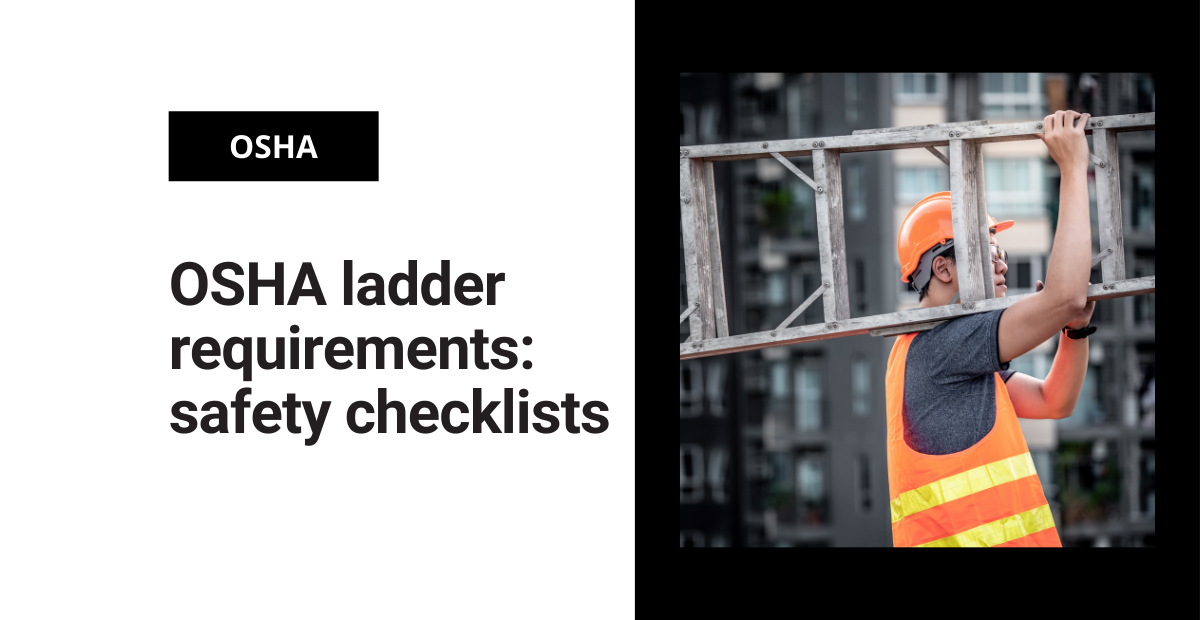OSHA ladder requirements provide guidance on proper use of both portable and fixed ladder. In this post, we break down OSHA’s guidelines into separate categories. When reviewing your EHS program, make sure you perform hazard assessments for all the equipment you have onsite.
General requirements of all ladders
All ladders have general requirements that companies must follow for safe use.
For OSHA ladder requirements, employers must ensure:
- Ladder rungs, steps, and cleats are parallel, level, and uniformly spaced when the ladder is in position for use.
- Ladder rungs, steps, and cleats must be spaced at least 10 inches (25 cm) apart but no more than 14 inches (36 cm) when measured between their centerlines. This spacing ensures that workers can safely climb and descend without overextending or losing balance. Additionally, maintaining uniform spacing across the ladder helps prevent missteps and reduces the risk of falls.
- Steps on stepstools are spaced not less than 8 inches (20 cm) apart and not more than 12 inches (30 cm) apart, as measured between the centerlines of the steps.
- Ladder rungs, steps, and cleats have a minimum width of 11.5 inches (29 cm) on portable ladders and 16 inches (41 cm) for fixed ladders.
- Wooden ladders do not have a coating of any material that may obscure structural defects.
- Metal ladders consist of corrosion-resistant material or have corrosion protectant applied.
- Ladder surfaces are free of puncture and laceration hazards.
- Workers only use ladders per their intended design.
- Workers inspect ladders before initial use in each work shift and more frequently as necessary to identify any visible defects that could cause employee injury.
- Tag any ladder with structural or other defects as “Dangerous: Do Not Use” or with similar language. You should also remove it from service until repaired or replaced.
- Each employee faces the ladder when climbing up or down.
- Each employee uses at least one hand to grasp the ladder when climbing up and down.
- Employees should not carry any object or load that could cause them to lose balance and fall while climbing the ladder.
Free checklist!
Use this basic checklist to perform ladder inspections. Customize the line items to fit the equipment you have onsite.
OSHA portable ladder requirements
Portable ladders (step, straight, combination, and extension) usually consist of side rails joined at intervals by steps, rungs, or cleats. They can be self-supporting or can lean against a supporting structure. Portable ladders have their requirements for safe use.
The employer must ensure:
- Portable metal ladders have corrugated, knurled, dimpled, coated with skid-resistant material, or treated rungs/steps to minimize slip incidents.
- Each stepladder or combination ladder used in a stepladder mode has a metal spreader or locking device that securely holds the front and back sections in an open position while the ladder is in use.
- Workers do not load ladders beyond the maximum capacity.
- Ladders are only on stable and level surfaces to ensure worker safety. However, if the surface is uneven or unstable, you must secure or stabilize the ladder to prevent it from shifting or tipping during use.
- No portable single rail ladders are available for use.
- No ladder moves, shifts, or extends while an employee is on it.
- Secure ladders if they are in passageways or doorways or use a temporary barricade. Examples of barricades include cones or caution tape.
- The cap (if equipped) and the top step of a stepladder should not be used as steps.
- To secure and stabilize ladders on slippery surfaces
- The top of a non-self-supporting ladder must rest so that both side rails are securely supported, ensuring stability while in use.
- Portable ladders used to gain access to an upper landing surface have side rails that extend at least 3 feet (0.9 m) above the upper landing surface.
- Employees do not fasten ladders and ladder sections together to provide more length unless part of their design specifications.
- Workers do not place ladders on boxes or other unstable surfaces to obtain additional height.
OSHA fixed ladder requirements
Fixed ladders permanently attach to a structure, building, or equipment. These include individual-rung ladders but not ship stairs, step bolts, or utility hole steps.
The employer must ensure:
- Fixed ladders can support their maximum intended load.
- The side rails of through or sidestep ladders extend 42 inches (1.1 m) above the top of the access level or landing platform served by the ladder.
- For through ladders, the steps or rungs are omitted from the extensions, and the side rails are flared to provide not less than 24 inches (61cm) and not more than 30 inches (76 cm) of clearance. Ladder safety systems must have a maximum clearance between side rails of no greater than 36 inches (91 cm).
- For sidestep ladders, the side rails, rungs, and steps must be continuous in the extension.
- The design of individual-rung ladders prevents the employee’s feet from sliding off the ends of the rungs.
- Workers must not use fixed ladders having a pitch greater than 90 degrees from the horizontal.
- Fixed ladders that do not have cages or wells must have a clear width of at least 15 inches (38 cm) on each side of the ladder centerline to the nearest permanent object and a minimum perpendicular distance of 30 inches (76 cm) from the centerline of the steps or rungs to the nearest object on the climbing side.
Grab bars and hatches
- Grab bars must extend 42 inches (1.1 m) above the access level or landing platforms served by the ladder.
- Grab bars do not protrude on the climbing side beyond the rungs of the ladder.
- The minimum perpendicular distance from the centerline of the steps, rungs, or grab bars to the nearest permanent object to the back of the ladder is 7 inches (18 cm)
- The minimum size (cross-section) of grab bars is the same as the rungs of the ladder.
- When a fixed ladder terminates at a hatch, the hatch cover must open with sufficient clearance to provide easy access. It must also open at least 70 degrees from horizontal if the hatch is counterbalanced.
Ladder training for employees
Abiding by the OSHA ladder requirements outlined in this post will help you avoid regulatory citations. But don’t forget the importance of training!
The last thing you want is for a ladder-related safety incident with no record of the worker receiving training. Always ensure that ladders are only available to workers who have the training to use them.





